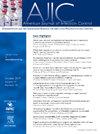“Don’t touch your face”---Effectiveness of a health communication intervention on reducing face-touching behaviors
IF 2.4
3区 医学
Q2 INFECTIOUS DISEASES
引用次数: 0
Abstract
Background
Given the risk of infection through face-touching behaviors, investigators have called for more research into the development of interventions to reduce the frequency of face-touching. The current study aims to test the effectiveness of messages on reducing face-touching behaviors.
Methods
Nine different messages that highlighted the risk of face-touching were developed. Study 1, an online survey-experiment with a national sample of US adults (N = 998), examined message-, risk perceptions, and face-touching-related behavioral intentions. The most promising messages identified in study 1 were then tested in study 2, a follow-up behavioral observation study with a class of undergraduate students. Students’ face-touching behaviors were observed during a 4-week period when intervention versus control messages were displayed in the classroom.
Results
Four messages performed better in study 1, 2 of which were selected to test the actual message effectiveness in study 2. Study 2 results showed that on average, students touched their faces less frequently when a “Don’t touch your face” message was present, although such decrease was not statistically significant.
Conclusions
Having reminder messages of “Don’t touch your face” in public spaces hold the potential to be a low-cost, effective strategy to reduce face-touching behaviors.
"不要摸脸"--健康传播干预对减少摸脸行为的效果。
背景:鉴于面部接触行为存在感染风险,调查人员呼吁开展更多研究,以制定减少面部接触频率的干预措施。本研究旨在测试信息对减少摸脸行为的有效性:方法:研究人员编写了九条不同的信息,强调了 "摸脸 "的风险。研究 1 是一项在线调查实验,以美国成年人(998 人)为全国样本,考察了信息认知、风险认知以及与 "摸脸 "相关的行为意向。在研究 1 中确定的最有前景的信息随后在研究 2 中进行了测试,研究 2 是对一个本科生班级进行的后续行为观察研究。在为期四周的时间里,在教室里展示干预信息和对照信息时,对学生的面部接触行为进行了观察:结果:有四条信息在研究 1 中表现较好,其中两条被选中用于测试研究 2 中信息的实际效果。研究 2 的结果显示,当出现 "请勿触摸你的脸 "的信息时,学生触摸脸部的频率平均降低了,尽管这种降低在统计学上并不显著:结论:在公共场所发布 "请勿摸脸 "的提示信息有可能成为一种低成本、有效的减少摸脸行为的策略。
本文章由计算机程序翻译,如有差异,请以英文原文为准。
求助全文
约1分钟内获得全文
求助全文
来源期刊
CiteScore
7.40
自引率
4.10%
发文量
479
审稿时长
24 days
期刊介绍:
AJIC covers key topics and issues in infection control and epidemiology. Infection control professionals, including physicians, nurses, and epidemiologists, rely on AJIC for peer-reviewed articles covering clinical topics as well as original research. As the official publication of the Association for Professionals in Infection Control and Epidemiology (APIC)

 求助内容:
求助内容: 应助结果提醒方式:
应助结果提醒方式:


